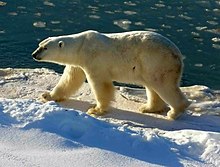Wapusk National Park is a national park north of 53 in Manitoba. It is one of the least-visited national parks in the country, having only received 82 visitors in 2022–23.
Understand
edit
The park is in the Hudson Plains ecozone, 45 km (28 mi) south of Churchill in north-east Manitoba on the shores of Hudson Bay. Access to the park is limited due to its remote location and an effort to preserve the park. The name comes from the Cree word for polar bear (wâpask). The park is also home to Cape Churchill, which is renowned as the best location in the world to view and photograph wild polar bears. The only way people can access Cape Churchill is by helicopter or Tundra Buggy.
Wapusk National Park covers 11,475 km2 (4,431 sq mi) park — bigger than Jamaica — and protects one of the world's largest known polar bear maternity denning areas. It includes a large part of the Hudson Bay Lowlands, a subarctic region bordering Hudson Bay that is mostly muskeg and wet peatlands. It is one of the wildest and most remote of Canadian landscapes.
History
editLandscape
editFlora and fauna
edit


One of the world's largest known polar bear maternity denning areas is in Wapusk National Park. The park is in the range of the Western Hudson Bay population of polar bears, which has remained stable at about 1000 bears.
Sea ice is the natural habitat of polar bears, and it's where they hunt the ring seal, their major food source. In fall, from late September to November, many of the bears migrate along the coast to catch the first pack ice of the winter. The number of bears peaks in the areas around Cape Churchill in the park, and along the coast between the park and the town of Churchill.
When the ice of the Hudson Bay melts in late July, the bears come ashore. While on shore, they gather along the coast and fast for about four months, until they can hunt seals again when the bay freezes. Pregnant females remain on land through the winter to give birth to their cubs and will fast for about eight months.
The active polar bear season is usually mid-summer to late fall.
This national park is also home to great grey owls, timber wolves, lemmings, ivory gulls, arctic foxes, peregrine falcons, snowshoe hares, red foxes, moose, wolverines, Caspian terns, and a herd of 3 000 Cape Churchill caribou.
Numerous birds are found in the Wapusk National Park and it is a likely breeding area of the short-billed dowitcher.
Climate
editSnowstorms can happen at any time of year.
May: temperatures range from −10 °C (14 °F) to 20 °C (68 °F).
June, July and August: temperatures range from −10 °C (14 °F) to 35 °C (95 °F), and are highly variable: they may plunge 20 degrees in less than an hour.
September and October: temperatures range from 25 °C (77 °F) to 15 °C (59 °F), and the weather is often stormy.
December and January: average temperature is 26 °C (79 °F), but it can drop as low as −50 °C (−58 °F), and wind chills may push make it feel as cold as −65 °C (−85 °F).
Visitor information
edit- Park website
- 1 Parks Canada Visitor Centre, 1 Mantayo Seepee Meskanow, Churchill, ☏ +1 204-675-8863, toll-free: +1-888-773-8888, wapusk.np@pc.gc.ca. Wapusk’s main entry point, Churchill, is the site of Parks Canada’s Visitor Centre.
Get in
edit
Churchill is 1,400 km (870 miles) northeast of Winnipeg, accessible by plane or Via Rail train. Access to the park is possible by a short helicopter tour over the park from Churchill, or as a multi-day visit organized by a licensed operator.
Churchill is the “gateway” community to Wapusk National Park.
Travel to the park from either Churchill or Gillam must be arranged with local licensed commercial operators; Parks Canada maintains an online list of licensed companies. Depending on the season, tour operators can take you to and from the park by boat, snowmobile, aircraft or dog team as there are no roads to the park. Weather conditions, ice, tides and seasonal conditions may affect your trip.
Fees and permits
editThere is no entry fee to this park. However, the tour guides are likely to charge fees for their services.
Get around
editSee and do
editLicensed tour operators
editAerial tours
edit- Hudson Bay Helicopters (Prairie Helicopters), info@prairiehelicopters.com.
- Custom Helicopters, ☏ +1 204-338-7953, toll-free: +1-800-782-0780, info@customheli.com.
Buy, eat and drink
editThere are no facilities other than the two Parks Canada compounds.
Sleep
editCamping
editThere are two multi-use fenced compounds owned by Parks Canada that can be used for safe camping in the park along on the Broad and Owl Rivers. They can be accessed by canoe, airplane or helicopter. These fenced compounds are bear-proof, have some limited facilities for fresh and waste water, and have washrooms.
Contact the park office to arrange for use of these areas.
Backcountry
editIn polar bear country? Just 'no'.
Stay safe
editIn addition to the Parks Canada bear-proof compounds, there is a privately-owned research camp south of Cape Churchill that is enclosed within a compound. It may be possible to use this camp in an emergency (i.e., equipment breakdown, severe weather event).
If you encounter a polar bear:
- Stay calm.
- Check that all people in your group are accounted for.
- Back away, facing the polar bear at all times.
- Get into your vehicle or a building as rapidly as possible.
- Do not run.
- Call for help by phoning Polar Bear Alert at +1 204-675-2327
Call the Polar Bear Alert Line if you:
- See a bear within or near the town limits
- See a bear between the town and the airport
- Observe a bear near the outlying residential areas or businesses (i.e. Goose Creek, Camp Nanuk, Churchill Northern Studies Centre)
- See a bear that appears to be injured
If there were any injuries, call 911.

